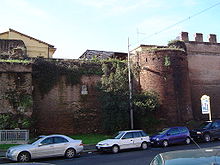Porta Nomentana
The Porta Nomentana was a gate in the Aurelian Wall in Rome , built between 271 and 275 AD . In ancient times, the gate was the starting point of the old Via Nomentana , which after a restructuring of the entire area and relocation of the road in 1564, its exit from the 75 meters away and which Michelangelo commissioned Pius VI. built Porta Pia takes.
The porta Nomentana gives a good impression of the original gates of the Aurelian Wall, as it is the only gate of the wall that has not undergone any major alterations or changes in its surface. Only with the construction of the Porta Pia was the passage closed with raw brickwork. The 2.90 meter wide and 5.5 meter high gate building had only one passage, which was flanked by two two-story towers. The surface was faced with fine brickwork. The complex had a flat roof reinforced with battlements over the towers and gate chamber.
As with many other gate structures of the Aurelian Wall, such as the Porta Salaria , ancient graves were built into this gate, some of which can be seen on the surface. In 1827, the southern tower was therefore laid down in order to be able to uncover the tomb of Quintus Haterius below , in which the suffect consul of the year 5 BC can be found. BC, the influential senator and rhetorician, mentioned frequently in Suetonius and Tacitus. The remains of a rectangular brick grave are still preserved under the northern tower.
The ancient name was used for the gate until the 13th century. But then this turned into Porta S. Agnese , as the gate opened the main path to the Basilica of Sant'Agnese fuori le mura .
literature
- Samuel Ball Platner , Thomas Ashby : A Topographical Dictionary of Ancient Rome. Oxford University Press, London 1929, p. 410 ( online ).
- Lawrence Richardson Jr .: A New Topographical Dictionary of Ancient Rome. Johns Hopkins University Press, Baltimore MD et al. 1992, ISBN 0-8018-4300-6 , p. 305.
Individual evidence
- ↑ CIL 6, 01426 .
- ^ Werner Eck : Haterius 2. In: Der Neue Pauly (DNP). Volume 5, Metzler, Stuttgart 1998, ISBN 3-476-01475-4 , Sp. 183.
Coordinates: 41 ° 54 ′ 30.8 " N , 12 ° 30 ′ 7.4" E
